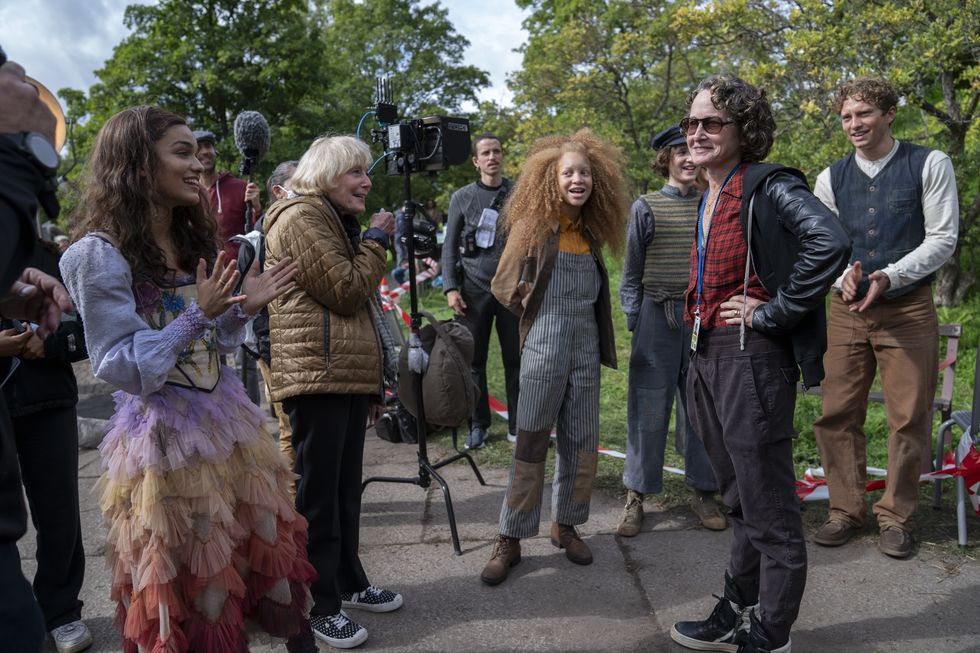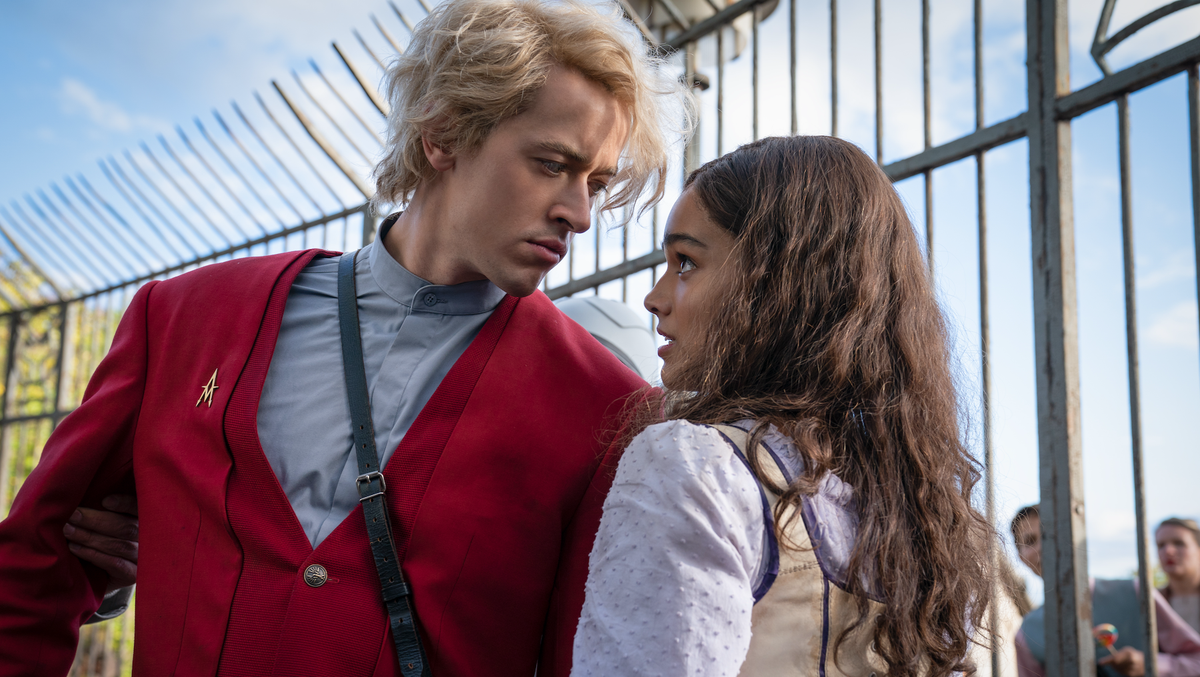Inside the ‘Big Message’ Behind the Costumes of The Hunger Games: The Ballad of Songbirds and Snakes
Time to get your mockingjay pins out of the storage unit: We’re headed back to The Hunger Games for another raucous round of children’s battle royale. But don’t expect the Games to look as flashy as you remember them. In the upcoming film The Hunger Games: The Ballad of Songbirds and Snakes, the franchise’s first installment in eight years, not only is Jennifer Lawrence’s Katniss Everdeen several decades out from her birthdate, but the Hunger Games themselves are only in their 10th iteration, and as such a lot sloppier than we’ve come to expect. Nor is Cinna around to style the District tributes in flame-catching gowns. But at least one familiar face has returned: Trish Summerville, costume designer for Catching Fire, is back outfitting Songbirds and Snakes—and ensuring the film’s “big message” is communicated in its clothes.
The prequel, which takes place in the early days following the Districts’ rebellion against the authoritarian Capitol, features Tom Blyth’s 18-year-old Coriolanus Snow (in his pre-presidential days) in crimson school uniforms and drab military fatigues, as his District 12 tribute—Rachel Zegler’s Lucy Gray Baird—gets her infamous rainbow dress nearly shredded to pieces in the Games. In the sneak-peek interview and Hunger Games featurette below, Summerville walks ELLE.com through the challenge of heading back to the world of Panem—and how she tied the prequel back to her origins in the franchise.
This isn’t your first time in the Hunger Games universe. What made you agree to come back and work in this world again?
Well, Francis [Lawrence, the director] called me and said, “Hey, I think we’re doing this again.” [Laughs.] And what really drew me in was: This film is so completely different than the one I did. The overall look of the film is so different than Catching Fire. It’s a much different color palette; it’s a much different environment. The tone is different, and all different actors as well.
How would you describe that difference in color and tone, even within the same fictional universe?
So in this one, we’re presenting the world as similar to the 1940s to 1950s—that type of feel and aesthetic. This film takes place 64 to 65 years before the original Hunger Games [series] happens. Going through the book and then having the script and talking to Francis, he really wanted it to have this post-war feeling. And then, as far as the coloration in the film … we have so much color and so much excess in the Capitol. And then the Districts are very dark and drab and depressed. For this one—since it’s so early, [the characters] have only seen ten Hunger Games [at this point]—I wanted to flip that, to show more life in the districts, of how joyful and how much of a community they had before the continual control of the Capitol took over. So instead of having them always in these dingy coal-mining type of clothes, we have these big scenes at the Hob where they’re dancing and they’re joyful and the bands are playing. Especially with Lucy Gray’s character and her band, the Covey, we have a lot of color there, a lot of embroidery.
For the Capitol, I kept the palette very solid tones and no prints, nothing floral in that world. [The style is] kind of communistic, very concrete, and it lends itself to the locations we were shooting in. We kept the Capitol definitely looking moneyed—you can tell that they have means, but keeping it very controlled, very classic, very contained.
Was there a challenge in taking the precedent of the original films and translating that to a prequel feature, which is itself being done almost a decade after the original films?
Having conversations with Francis and Nina Jacobson, who’s the producer that’s been attached to all the films, [we were] trying to figure out what we could present that’s new and fresh, while also keeping the fan base satiated. Katniss was such a hero in all these films and so liked, and is this kind of warrior. [In Songbirds and Snakes], most of the characters are all new; the only repeating characters we have are Snow and Tigris.
So looking at that, I was thinking of where, especially in the clothing, I could give the fans a little bit of a taste of where the Capitol’s going, where the Hunger Games are going. So I chose to do that with the characters that made sense, like Tigris, like Snow and his family—because they’re having this facade of still having money and means and upholding their family heritage.
And then doing a couple little Easter eggs. With Lucy Gray’s corset that she wears, that’s the same shaped corset that I put on Katniss and her blue mockingjay dress, which she spins and the wings come out. And the hand-painting on Lucy Gray’s corset, we did the snakes to keep the theme of Lucy Gray’s kinship with snakes, but also painted in katniss flowers and primrose flowers. So we kind of give a nod to the future of where the Hunger Games is going.
I want to talk specifically about Lucy Gray’s dress. It’s the first thing that she’s seen in; it’s what she wears for the bulk of the story. You had to have the ruffles; you had to have the rainbow. Knowing that that was what you had to work with, how did the final design come together?
As you read something on the page, everyone’s interpretation is quite different as to what that should be. [The dress] was definitely something I started with in the beginning, because it was a big tackle.
I worked early on with an illustrator and started pulling in various fabrics and doing fabrics swatching and testing. I did do quite a few dresses, and I never felt in the illustrations, Oh, that’s it. I’m a pretty decisive person, especially at work. I don’t waver. So then I stopped completely on that and I started working on Tigris, and then I went back to Lucy. I had two different illustrators working, going back and forth with different characters because of our timeframe. And I decided I wanted to lean a bit more into the Katniss feel … so doing the corset and figuring out if we could do embroidery or hand-painting on the corset.
With the skirt, I really love dégradé and ombre kind of fabrics. I wanted it to be dusted down and not too bright, because in the time period we’re in, what do rainbows look like then? With our sky and how sunsets have changed, what does that look like? And knowing it was a lineage heritage piece that had been passed down through Lucy Gray’s family, it couldn’t be brand new.
So we swatched tons of fabrics and came up with the idea of toile, because it has some stretch and give for all the stunts and crawling she has to do. We got a swatch card from Western Costume of every color toile in the world and then started laying them out to see what was the most complementary and how many of those we could fit in. We then configured what the size of each ruffle could be, how many ruffles we could have, and then did the under layers of the skirt with some metallics, so that we could get shine through it. We put bloomers under her dress, which could also hide pads. So it did take a lot of thought. We ended up making about eight to 10 [versions] of the dress, for all the stunts and all the aging. It was a big undertaking, but I think it looks really beautiful.
Tell me about the Capitol’s Academy uniforms and that specific choice to use red. It did bring to mind some of the imagery from Catching Fire and Mockingjay.
I like the use of red when it’s appropriate in a film, because it does draw your eye immediately, and it can be distracting and soak up the attention. Having conversations with Francis and then the production designer and the locations managers, being able to see the environments we were shooting in—I saw that there wasn’t a lot of color and they were very stark.
So I brought up, well, we have so much gray and we have so much stone and so many neutral tones, I really wanted to do the uniforms in red. Francis was cool with that idea and liked it. When I saw what the arena would look like and the school and the stairs that [the characters] walk up, it’s like this veining of blood going up and into buildings and flowing out and back down.
Anything that’s according to the Capitol has to be uniform because you can’t be individual and stand out. It’s the same thing with the Peacekeepers. The fatigues for bootcamp, you’re all the same. With the school uniforms, you’re all the same. So I wanted there to be: Whatever gender you were, you had the same thing on. I really love how it looks in all these environments, and I think choosing that tone—having a lot of blue undertones in that red, and a deep saturated red—I think works on everyone’s skin tone.
What did the costuming in this film need to communicate in order for you to feel it was done effectively?
I think it was showing a progression of time and control with government. I mean, these stories do have a really big message in them. These books have a really big message and we hope that the target audience, besides enjoying the story, do catch on to what these messages are. And I think in this one particularly, we had the opportunity to show joy in the Districts. Lucy Gray’s character is much different than, say, Katniss, in her approach to survival, and having this band that she’s a part of, and this love story unfolding in the beginning. I think it was important to convey that through the clothing, the environment, also with the hair and makeup.
And then also showing the individuality of each district—because, this time, when they’re in the Games, they’re in their own clothing from their districts. So having them be dressed up pridefully in what I always consider, like, their Sunday best—whether you’re in the movie and you’re the audience of the Capitol or watching the movie as the audience, you can identify which district each person came from and you get to develop this bond. Whereas in the later films, they’re all given a uniform that they have to compete in. So I wanted to show that this is how the Games started—and where we progressed to later.
This interview has been edited and condensed for clarity.
Watch the exclusive debut of a sneak-peek video below to learn more about the costumes of The Hunger Games: The Ballad of Songbirds and Snakes.
Culture Writer
Lauren Puckett-Pope is a staff culture writer at ELLE, where she primarily covers film, television and books. She was previously an associate editor at ELLE.




